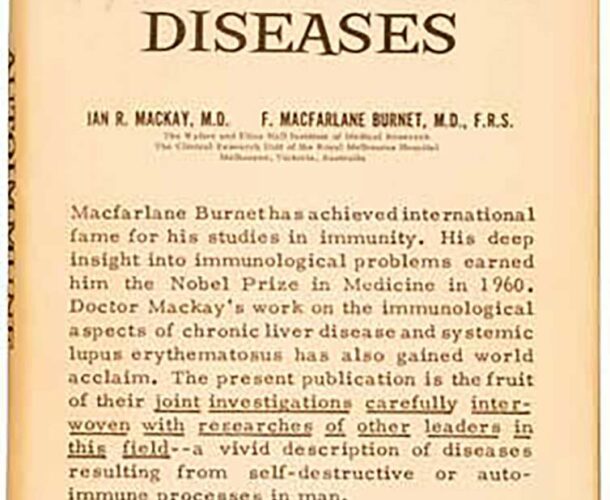In 1962 institute researchers Professor Ian Mackay and Sir Frank Macfarlane Burnet propose a radical theory: that the immune system can go awry and attack the body’s own tissues, causing autoimmune disease.
At the time the scientific community had difficulty accepting that the body’s immune system could ‘turn’ on its own tissues and cause disease.
In 2012, more than 80 specific autoimmune diseases are recognised, likely affecting more than 5 per cent of the Australian population.1
“The past 50 years have seen autoimmunity transformed from an abstrusely arcane idea into what is now a widely familiar household term,”2 Mackay reflected five decades after he and Burnet published the first book bold enough to focus on autoimmune diseases.
Autoimmunity: from wild idea to accepted theory
Until the early 1960s, most of the diseases within the autoimmune umbrella were listed as ‘of unknown cause’. Within a decade or so, their autoimmune nature was revealed, a ‘seismic shift in the landscape of medicine’, as Mackay has put it.
The idea of autoimmunity “had been thought about since the 1900s,” Mackay says. The concept had been proposed by Paul Ehrlich, but had quickly disappeared from immunologists view as it was “a state that was almost incompatible with life”, therefore could not exist.
Mackay says in the 1950s and 60s, he was one of the “few people in the world that identified autoimmune disease as a cause of illness”.
“Our interests in those early days was ascertaining whether the body was indeed completely protected from autoimmune injury and ensuing disease, as it was then believed. But our evidence suggested otherwise, and implicated autoimmunity in many familiar but hitherto unexplained diseases, chronic hepatitis, gastritis, Sjogrens disease multiple sclerosis and others, each being attributable to an intrinsic immunological error. Then the next task was to determine the nature of this – an endeavour that is still proceeding worldwide.”
According to Mackay, “Burnet’s longest and most passionate concern in science – he refers to it as an obsession – was the enigma of self-non-self discrimination by the immune system.”3
“Burnet had an absolutely unqualified conviction that the truth and reality of autoimmune disease was regarded by the majority of clinical and theoretical scientists at the time as a crackpot idea. Notwithstanding, Mac was able to write around it theoretical ideas that are still current today.”
The first book on autoimmune diseases
In 1962 Mackay says “there was enough information to ‘lay it on the line’, with the publication of Autoimmune Diseases.
“Our text presciently included all of the currently accepted autoimmune diseases, with one notable exception, juvenile diabetes (autoimmune insulitis)–it was suspected, but the climate of opinion on autoimmunity then was too prejudicial!”
Initially opposition – even derision – greeted the concept of autoimmune disease
“Authors put autoimmune in quotation marks, or prefixed it with “so-called”, or spoke non-committally of “hypersensitivity disease”. In addition to published evidence, we adopted the ‘populist’ Friday morning case presentations of the [Clinical Research Unit] at which a wide variety of autoimmune syndromes were discussed in depth. Burnet and Gus [Sir Gustav Nossal] were regular attendees – and commentators – at these presentations.
In 2012, the Medical Journal of Australia published an article commemorating the 50th anniversary of the publication of Autoimmune Diseases.
Mackay and Burnet’s monograph was described as “a founding text and marked the beginning of autoimmunity as a clinical science. It’s insightful concepts and novel ideas inspired a generation of clinical and basic immunological researchers.1
“Mackay and Burnet were able to define autoimmune disease as a condition in which structural or functional damage is produced by the action of immunologically competent cells or antibodies against normal components of the body” and which arose by “the emergence of forbidden clones” of lymphocytes.
Mackay says a mint copy of Autoimmune Diseases is now a collector’s item.
“It is a source of considerable satisfaction that the Hall Institute in general, and the head of its Clinical Research Unit Dr Ian Mackay in particular, were among the pioneers of the concept of autoimmunity at a time when conservative elements of the medical profession strongly opposed the now universally accepted view that the immune system could do harm as well as good.”
“Until the early 1960s, most of the diseases within the autoimmune umbrella were listed as ‘of unknown cause’. Within a decade or so, their autoimmune nature was revealed, a ‘seismic shift in the landscape of medicine’.
In many ways, Mackay and Burnet’s book The Autoimmune Diseases published in 1963 was the key signpost. Since then, Mackay’s texts on autoimmune disease.
His text The Autoimmune Diseases, co-authored by leading US autoimmunity researcher Professor Noel Rose, was first published in 1964 and is now on its fourth edition, and has expanded to more than 1000 pages.
1 Roberts-Thomson, PJ, Jackson MW, Gordon TP. A seminal monograph: Mackay and Burnet’s Autoimmune diseases. Medical Journal of Australia, 2012, 196(1):74-76
2 Walter and Eliza Institute, Quintuple anniversary booklet.
3 The Walter and Eliza Hall Institute of Medical Research, Annual Review 1978-79






